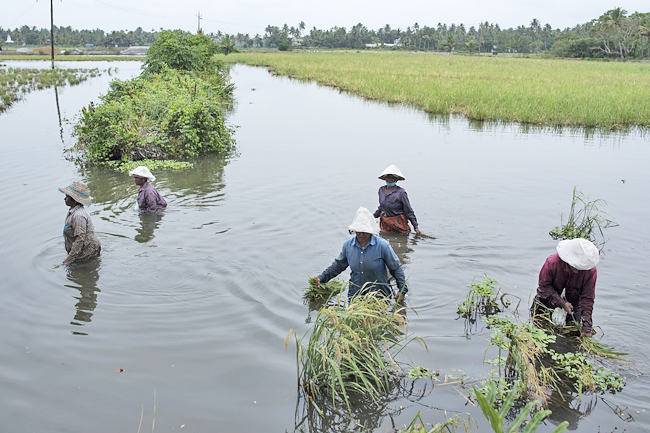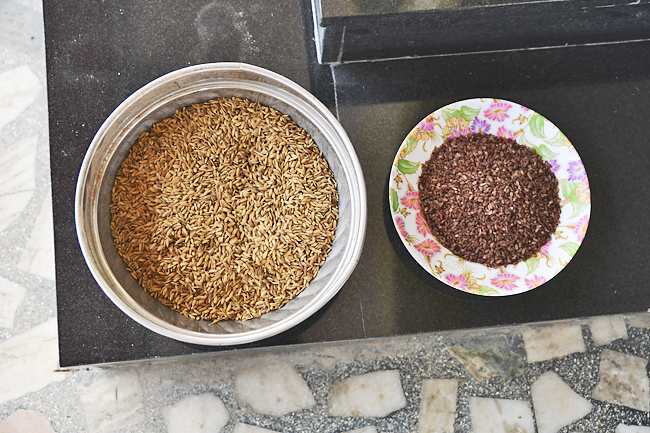KOCHI, INDIA (AP) – On a tiny sliver land in southern India, the future of an ancient grain that helps combat climate change is in doubt.
An ongoing tussle in Chellanam village, a suburb of the bustling city of Kochi, which has the Arabian Sea on one side and estuaries on the other, could decide the fate of the cultivation of pokkali rice.
In many wetlands in the area, farmers have traditionally dedicated half the year to pokkali rice and the other six months to prawns. In 2022, the Fisheries Department of Kerala issued an order that farmers no longer needed to dedicate part of the year to pokkali, exacerbating a trend away from pokkali already under way. While prawns fetch more money than pokkali, a focus on them is upending a delicate ecosystem, making it difficult for farmers who want to continue with pokkali, environmental experts say.
M M Chandu, a 78-year-old farmer with about 0.8 hectares said that increasing salinity in the land from year-round prawn cultivation was degrading soil and making it more difficult for him to grow pokkali.
“Everything was ruined” when farmers were pushed away from pokkali and toward aquaculture, he said.
When pokkali is grown, salt water is pushed out and farmers use rain water to irrigate their crops. Stalks from the pokkali later become food for prawns. That arrangement produces two kinds of crops and maintains natural barriers to rising seas and sequesters carbon in the soil.



“Pokkali is the oldest variety of rice in Kerala, which is at least 3,000 years old. It is also among the oldest known crops cultivated by organic farming methodologies in the world,” said Francis Kalathunkal, from the Pokkali Samrakshana Samithi, a group formed in 2011 to encourage farmers to cultivate pokkali.
Kalathunkal said in the 1990s, pokkali was grown on 485 hectares in Chellanam compared to just two to four hectares today. Across Kerala, it’s a similar story: two decades ago, pokkali was cultivated on more than 25,000 hectares in Ernakulam, Alappuzha and Thrissur districts compared to about 1,000 hectares today, according to Shan AC, president of Palliyakkal Service Cooperative Bank, which works with pokkali farmers in the production, procurement and distribution of the grains.
Pokkali is also being cultivated on experimental basis in the Sundarbans region of West BengaI, after vast tracts of paddy lands were filled with brackish water during a large cyclone in May 2021. A long grain version of pokkali is cultivated along the southwestern coastal belt of Sri Lanka.
Rice is the staple of southern and eastern parts of India, and is highly water intensive.
About 3.35 cubic metres of water are needed to grow one kilogramme (kg) of rice, according to India’s Commission for Agricultural Costs and Prices. Pokkali, by contrast, doesn’t require groundwater for irrigation, as it is cultivated in low lying wetlands that are inundated with rain water.
Compared to white rice, pokkali, rich in antioxidants, requires a longer time to cook. It has a more pronounced flavour and texture, making it an acquired taste for many. Some varieties have thick or long grains, and colours range from dark brown to white.
To make pokkali enticing – both for consumers and farmers – the Rice Research Station at Kerala Agricultural University is working to develop new kinds. So far, they have come up with 11 high-yielding varieties.
Just developing more pokkali options alone will not solve the larger issues, said head of the Rice Research Station Dr A K Sreelatha.
“The biggest problem is the unavailability of skilled labourers,” Dr Sreelatha said. “The soil is so soft that the various prototypes of machines developed (to harvest it) failed.”
Joint director at the Fisheries Department of Kerala Mahesh S said a 2010 law allows the department to issue licences for aqua farming on land that has been left fallow. If a farmer claims the land is not being used for paddy cultivation, “we will make a field visit and if we find the claim to be true, we issue a licence”, he said.
Because the crop floats in water, mechanised paddy cutters cannot be used. Instead, pokkali requires labourers, today mostly women, that stand in the water and cut the matured stalks manually, bundle them and bring them to the bund.
Chathamma, another suburb of Kochi, is surrounded by a salt water lake, making it perfect for pokkali-prawn farming. Yet, Nandakumar VM is forced to leave 20 hectares of his 28-hectare holding fallow during paddy season, as he could not find enough people to help harvest.
“It is really difficult to get people to come and work these days,” he said. “They don’t want to stand in knee deep water – sometimes even chest deep – to harvest the stalks.”
The lack of a market is yet another barrier to making money with pokkali. “This rice is known only in this region. If you go to the north of Kerala or to its hills, people do not know the benefits of pokkali,” said Dr Sreelatha.
A father-son duo, Joseph and Tom PV, who own seven acres in Chathamma, manage better, thanks to Tom’s marketing efforts.
When he could not convince his father to get into year-round prawn cultivation, Tom reached a deal with him: “Grow pokkali, but leave marketing to me.”
The hacks that the software engineer has come up with – add value by selling the finished rice and not just the paddy, branding and selling online – are bringing in more money.
Three years ago, the family made INR60 to INR80 (USD0.75 to USD1) per kg. Today, thanks to processing the rice and branding, they are making between INR120 and INR150 (USD1.46 and USD1.83). Impressed, other farmers in Chathamma have started trying to follow the pair’s footsteps, but Tom is sceptical.
“None of them know how to make money,” he said.
Environmental experts said that if the Chellanam model – a focus just on prawns – wins out, it would prove unsustainable to Kerala, which comprises 13 per cent coastal wetlands.
Founder of Thanal Agroecology Centre, which does research and training on sustainable agriculture Usha S said managing land that way in Chellanam is already having an impact. Soil has become more acidic, making it more difficult to cultivate pokkali, while sources of drinking water have become saltier.
“This has led to the fields being left fallow,” she said, adding that on fallowed lands farmers don’t bother fortifying tidal embankments, which leads to yet more salt.
In post graduate work at Kerala Agricultural University, Anju Sajan studied three kinds of land use: the pokkali-prawn combo, just pokkali and just prawns.
She concluded that the pokkali-prawn combination produced soil most apt to store carbon, which combats climate change.
For 99-year-old matriarch, Baby Joseph Kalathungal, who has been growing pokkali since she was 17 years old, the science behind the decline in pokkali doesn’t make much sense.
All she knows is that her stately home in Chellanam, which withstood the test of time for nearly a century, is corroding and her granary is empty.
While her family’s one hectare no longer produces viable yields, they still grow pokkali because they are part of a farmers’ collective holding out against all-year fish farming.
“I have seen it all, but even for me what is happening now is a bit too much to digest,” she said.







